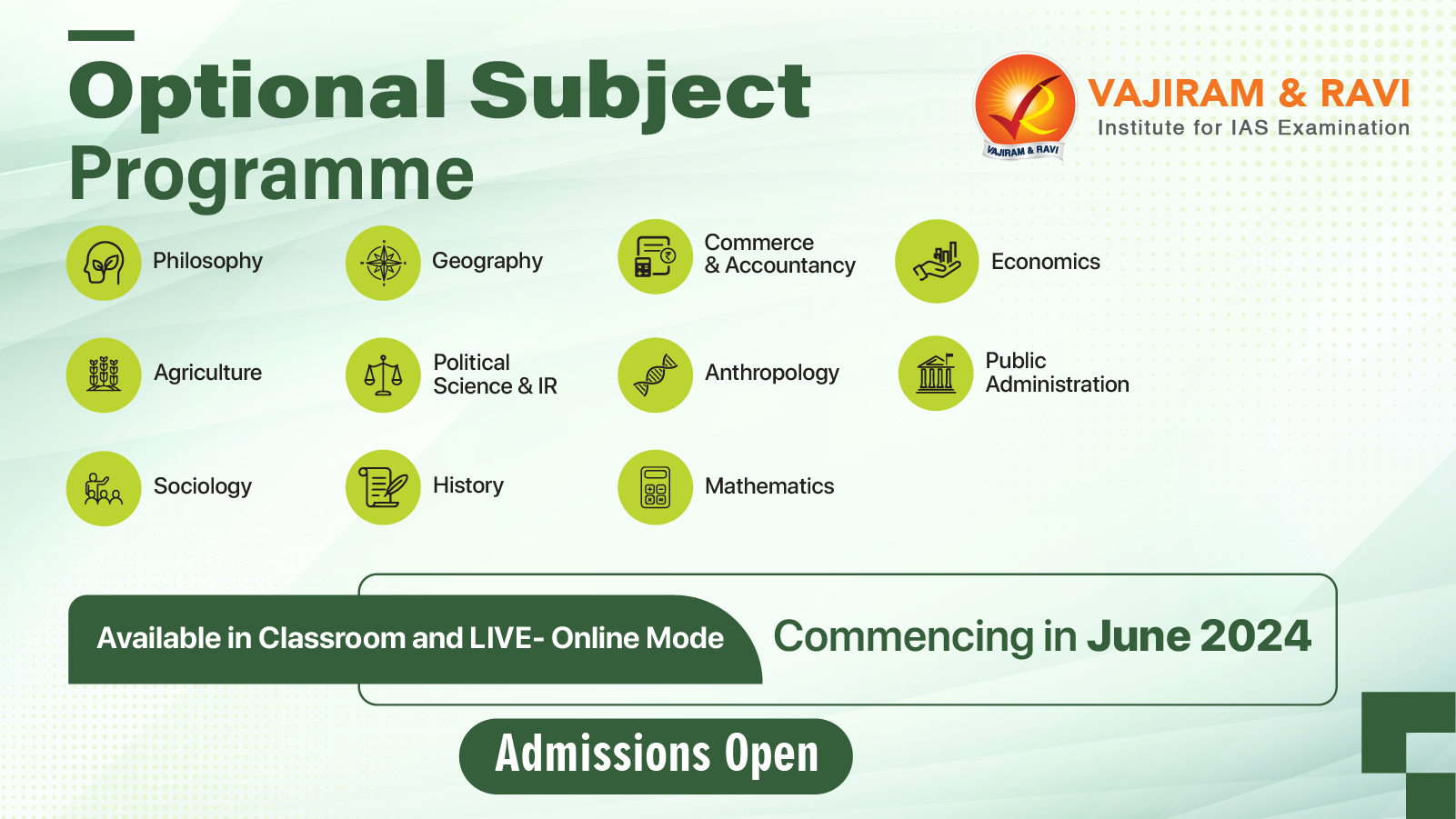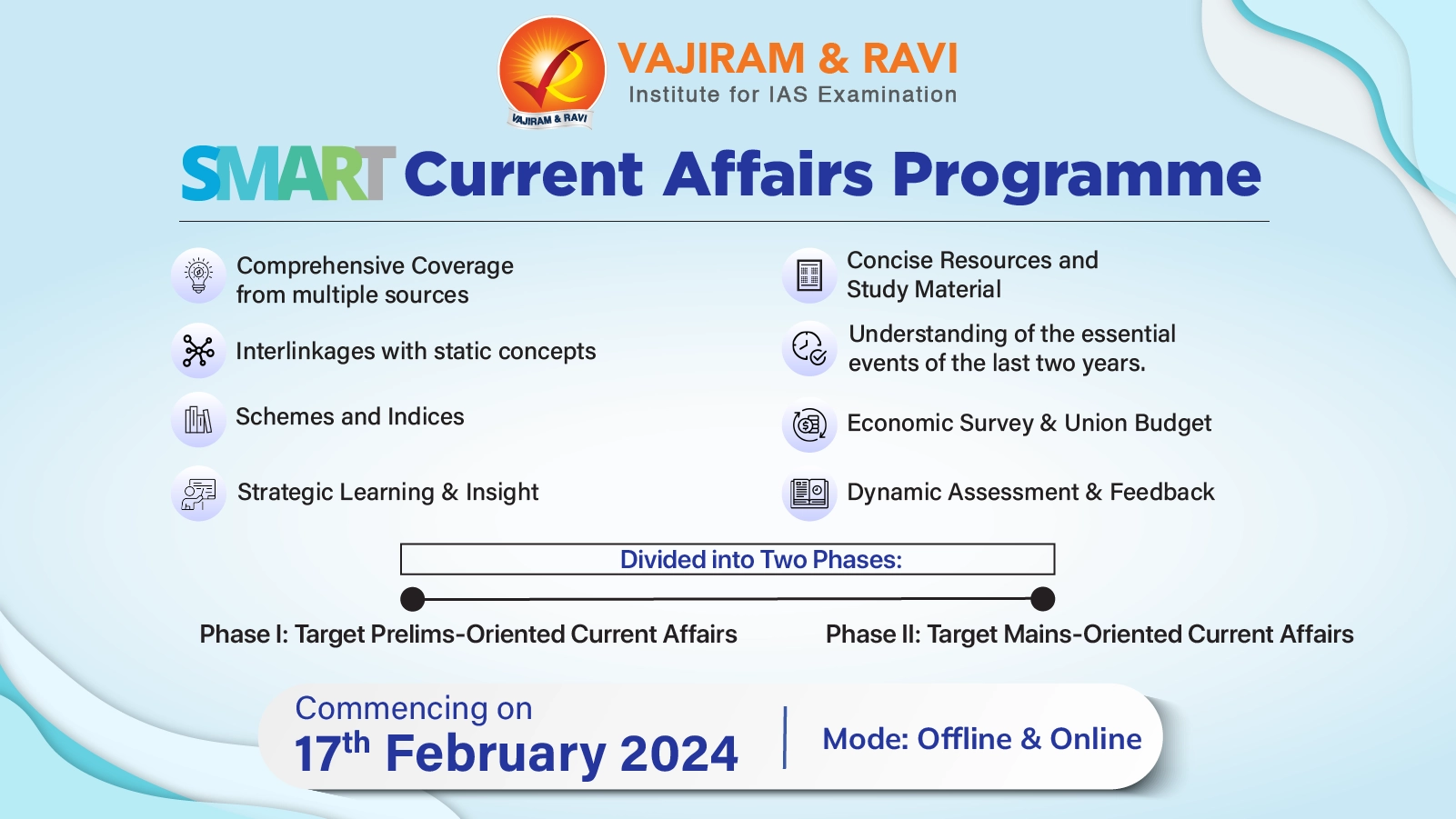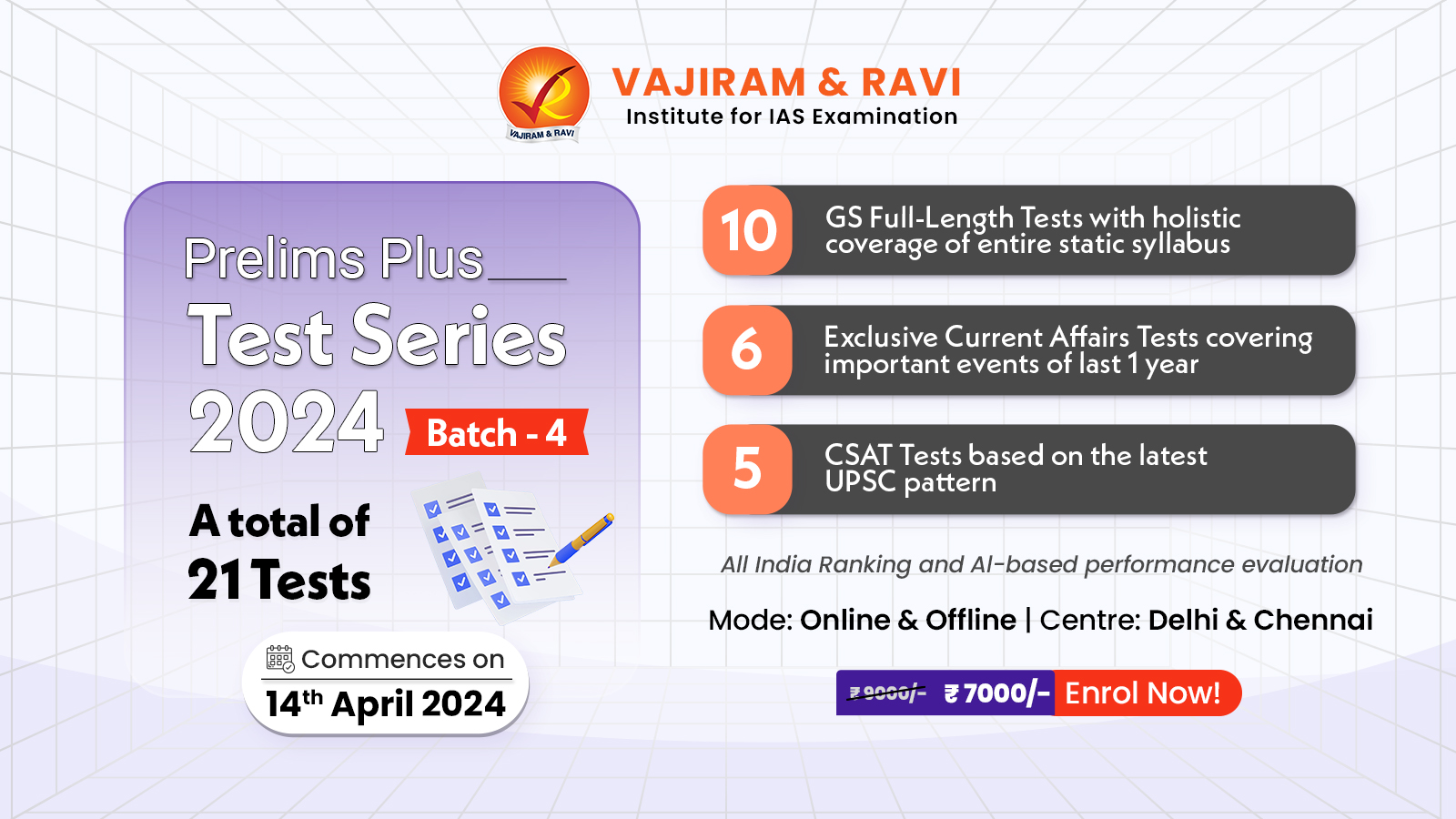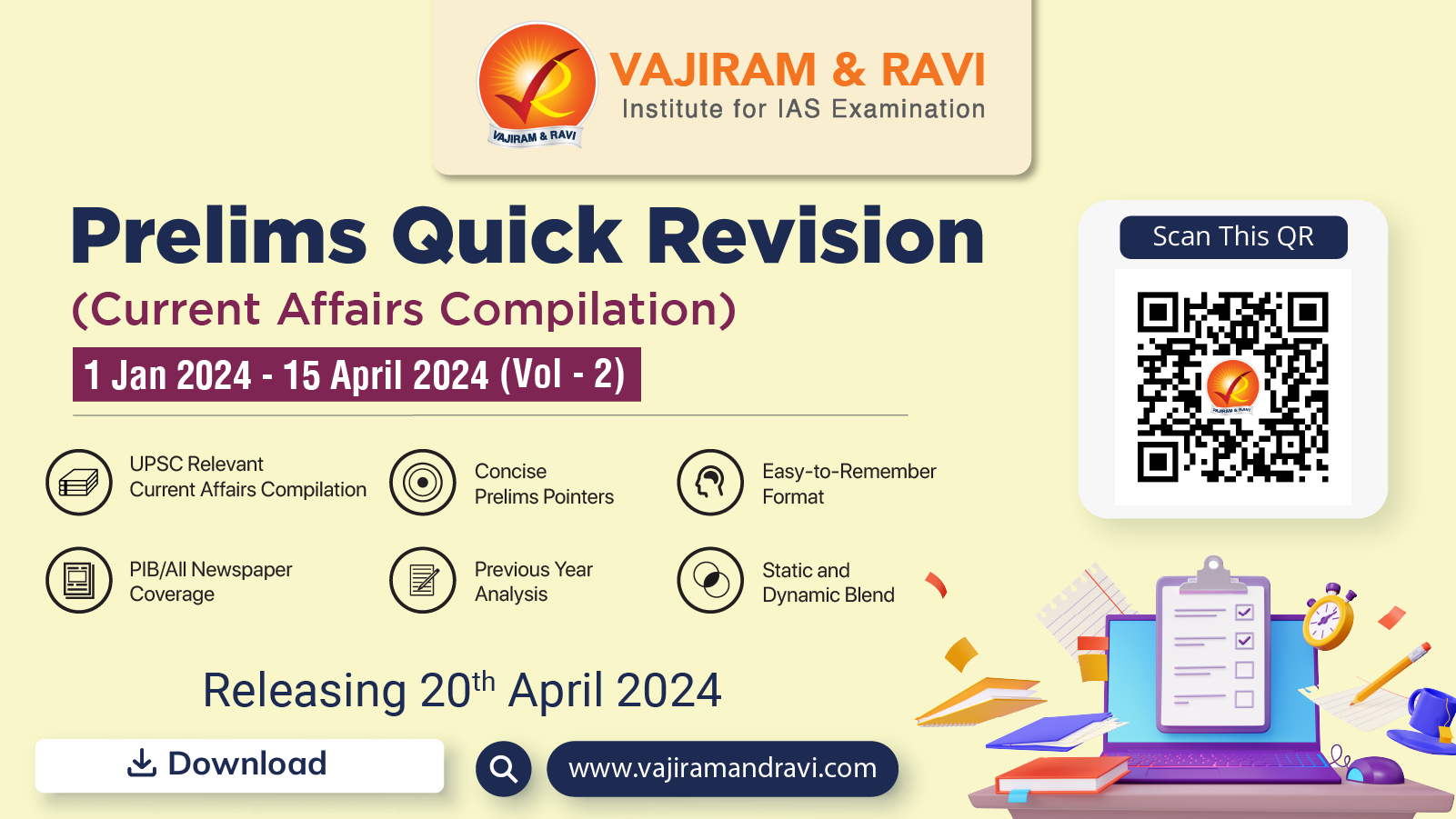Upcoming Mentoring Sessions
RMS - Art & Culture - Current Affairs 2023-24
RMS - Art & Culture - Architecture 2
RMS - Polity - DPSP & FD
RMS - Medieval History - Delhi Sultanate
RMS - Polity - Parliament 3
RMS - Geography - India Mapping
RMS - Art & Culture - Architecture 1
Mentoring Sessions (2024-25) - How to Start Preparation?
RMS - Geography - World Mapping
RMS - Ancient History - Guptas to Harshvardhana
RMS - Polity - Parliament 2
Prelims 2024 Strategy Session
RMS - Ancient History - Mauryan and Post-Mauryan Age
RMS - Polity - Parliament 1
RMS - Geography - Major Landforms
RMS - Polity - Judiciary - 2
RMS - Economics - Money and Banking - 2
Mentoring Session (2024-25) - How to Make Notes?
RMS - Polity - Judiciary 1
General Mentoring Session
RMS - Modern History - Constitutional Developments - Important Acts in British India
RMS - Ancient History - Buddhism and Jainism
RMS - Economics - Human Resource and HRD
RMS - History - Ancient India - Mahajanpadas
RMS - Economics - Balance of Payment and Foreign Trade
Mentoring Session (2024-25) – How to Read and Analyse Newspaper?
Mentoring Session (2024-25) - How to write an Answer?
RMS - Economics - Money and Banking-I
Article
19 May 2024
Why in news?
The human papilloma virus (HPV) vaccine is reducing cases of cervical cancer. This reduction is happening across all socio-economic groups. Most cases are being prevented in more deprived groups. This information comes from a major study funded by Cancer Research UK.
The researchers at the Queen Mary University of London carried out the longest follow-up on the effectiveness of the HPV vaccination programme in England.
What’s in today’s article?
- Cervical cancer – About, prevalence, prevention
- Key highlights of the study
Cervical cancer
- About:
- Almost all cervical cancer cases are linked to certain strains of HPV, a common virus that is transmitted through sexual contact.
- The body’s immune system usually gets rid of the HPV infection naturally within two years.
- However, in a small percentage of people the virus can linger over time and turn some normal cells into abnormal cells and then cancer.
- It is preventable as long as it is detected early and managed effectively.
- Prevalence in India
- Cervical cancer is the second most common cancer type and the second leading cause of cancer death in women of reproductive age (15-44) worldwide.
- According to the World Health Organization's International Agency for Research on Cancer (IARC-WHO), India accounts for approximately one-fifth of the global burden.
- India witnesses 1.23 lakh cases and approximately 67,000 deaths each year (one woman every eight minutes).
- Prevention
- Cervical cancer screening and vaccination are two effective preventive measures.
- There is still little awareness among women about this cancer prevention, and less than 10% of Indian women are screened.
- All women aged 30-49, regardless of symptoms, should be screened for cervical cancer and their adolescent daughters vaccinated against HPV.
- Vaccines available in India
- CERVAVAC is India’s first indigenously developed vaccine to prevent cervical cancer. It has been developed by Serum Institute of India (SII).
- It is a quadrivalent vaccine, meaning it is effective against at least four variants of cancer-causing Human Papilloma Virus (HPV).
- It is based on VLP (virus-like particles), similar to the hepatitis B vaccine, and provides protection by generating antibodies against the HPV protein.
- VLP approach stimulates an immune response from the body resulting in production of antibodies.
- Besides CERVAVAC, two vaccines licensed globally are available in India;
- a quadrivalent vaccine (Gardasil, marketed by Merck) and
- a bivalent vaccine (Cervarix, marketed by Glaxo Smith Kline).
- These vaccines are costly and hence are unaffordable for the vast majority of Indians.
- CERVAVAC is India’s first indigenously developed vaccine to prevent cervical cancer. It has been developed by Serum Institute of India (SII).
- Vaccine to be part of the universal immunisation programme
- An affordable and indigenously developed HPV vaccine to prevent cervical cancer is now ready.
- It will likely be included by the Union government in its universal immunisation programme.
Key highlights of the study
- More cases were prevented in the most deprived group
- As per the study, the HPV vaccine is cutting cases of cervical cancer right across the socio-economic spectrum, with most cases being prevented in more deprived group.
- Due to a typically higher incidence of cervical cancer in more deprived groups, researchers found that more cases were prevented in the most deprived group, compared to the least deprived group.
- As per the study, the HPV vaccine is cutting cases of cervical cancer right across the socio-economic spectrum, with most cases being prevented in more deprived group.
- Huge success of the school-based vaccination programme
- The study reflected the huge success of the school-based vaccination programme, showing that well-executed public health interventions can help to reduce health inequalities.
- HPV vaccination works
- Researchers found that over 12 years, the HPV vaccine reduced cervical cancer rates by nearly 90%.
- It also reduced pre-cancerous conditions by around 95%. This reduction was seen in women who received the vaccine at 12-13 years old in England.
- The HPV vaccination programme was first introduced to England in 2008.
- The study shows the vaccine is much more effective when given to children at 12-13 years old than later in life.
Article
19 May 2024
Why in news?
In March 2024, the National Investigation Agency (NIA) filed a charge sheet in a court in Guwahati. The charge sheet accuses the "China-Myanmar module" of the Isak-Muivah faction of the National Socialist Council of Nagaland (NSCN).
According to the NIA, this group is helping members of two banned Meitei outfits. These outfits are the People’s Liberation Army (PLA) and Kanglei Yaol Kanba Lup (KYKL). The NIA claims that these groups are being supported to infiltrate India.
What’s in today’s article?
- Main ethnic groupings of Manipur
- Insurgency in Manipur
- Naga Insurgency
Main ethnic groupings of Manipur
- The Meitei, Naga and Kuki-Zomi-Mizo are the three main ethnic groupings in Manipur.
- The Meiteis, the largest community, account for about 53% of the State’s total population of 27.21 lakh (2011 Census).
- The Nagas and the Kuki-Zo which are categorised into 34 Scheduled Tribes constitute 17% and 26% of the population respectively.
Insurgency in Manipur
- About
- There is an ongoing armed conflict between India and a number of separatist rebel groups in Manipur.
- This insurgency in Manipur is part of the wider Insurgency in Northeast India which combines elements of a national liberation war as well as an ethnic conflict.
- Historical background
- Following the brief Anglo-Manipur War of 1891, the Kingdom of Manipur was conquered by Britain.
- After this war, Manipur kingdom became a British protectorate.
- Manipur became a part of India in October 1949 and became a separate state in 1972.
- Following the brief Anglo-Manipur War of 1891, the Kingdom of Manipur was conquered by Britain.
- Rise of insurgency
- Manipur's incorporation into the Indian state led to the formation of a number of insurgent organisations.
- These groups demanded the creation of an independent state within the borders of Manipur, and dismissed the merger with India as involuntary.
- The insurgency problem in Manipur came into existence in the late 1960s and 1970s.
- There was no problem of insurgency when Manipur merged into India.
- The first separatist faction, United National Liberation Front (UNLF), was founded in November 1964.
- Later, the insurgency took another form when the Kuki-Naga clashes started to take place in the 1990s where hundreds were killed.
- The clashes and killings happened after the NSCN demanded that Kuki-Zo-inhabited areas be included in its proposed ‘Greater Nagaland’ project in the 1980s.
- The insurgent groups demanded an independent land for the Kuki-Zo people.
- Manipur's incorporation into the Indian state led to the formation of a number of insurgent organisations.
- Are there other active insurgent groups?
- There are nearly 30 Kuki insurgent groups in Manipur, of which 25 are under tripartite Suspension of Operations (SoO) with the Government of India and the state.
- In 2008, 24 Kuki-Zo insurgent groups under the umbrella of the United Peoples’ Front (UPF) and the Kuki National Organisation (KNO) signed a tripartite SoO pact with the MHA and the Manipur government.
- In February 2024, when the pact came up for an annual extension, the Manipur government refused to send a representative.
- Manipur Chief Minister N. Biren Singh has accused the groups of violating the ground rules and instigating violence in the State.
- There are nearly 30 Kuki insurgent groups in Manipur, of which 25 are under tripartite Suspension of Operations (SoO) with the Government of India and the state.
Naga Insurgency
- Background:
- The Naga National Council (NNC) was formed in April 1946 to carry out social and political upliftment of the Nagas.
- After the return of the radical leader of Naga cause, Angami Zapu Phizo, from Burma in 1947, the faction of NNC demanding full impendence grew strong.
- Shillong Accord and the split of NNC
- The Shillong Accord was signed in 1975 by Government of India with a section of the NNC leaders.
- As part of the accord, the leaders agreed to abjure violence and work towards the solution of the Naga problem within the framework of the Indian Constitution.
- It was opposed by Phizo, Isak Swu and Muivah. Later, Isak Swu and Muivah formed the "National Socialist Council of Nagaland (NSCN)" in January 1980.
- Later, NSCN split into two factions, namely NCSN (I-M) led by Isak & Muivah and NCSN (K) led by Khaplang.
- Demand for Greater Nagaland
- The NSCN-IM, has been demanding:
- ‘Greater Nagaland,’ an extension of Nagaland’s borders by including Naga-dominated areas in neighbouring Assam, Manipur and Arunachal Pradesh, to unite more than 1.2 million Nagas,
- a separate flag and
- a constitution.
- The NSCN-IM, has been demanding:
- Naga Peace Accord
- Since 1997, NSCN (I-M) has been involved in negotiations with the Government of India and signed many ceasefire agreements.
- 2015 Framework Agreement (FA)
- On August 3, 2015, the Centre signed a framework agreement with the NSCN (I-M) to resolve the Naga issue.
- The agreement was only a framework, with many details still to be hammered out.
- Talks were being held regularly to chart out the finer details of the FA.
- In June 2022, talks broke down after the NSCN accused the interlocuter appointed by the Centre of excluding three political points.
Charge sheet filed by NIA accusing NSCN
- Significance
- The charge sheet was filed against five personsand is the first official statement of links between the NSCN-IM and Imphal valley-based insurgent groups during the current ethnic crisis.
- On 3 May 2023, ethnic violence erupted in India's north-eastern state of Manipur between the Meitei people, a majority that lives in the Imphal Valley, and the Kuki-Zo tribal community from the surrounding hills.
- Tensions boiled over when Kukis began protesting against demands from the Meiteis to be given official tribal status.
- The Kukis argued that this would strengthen their already strong influence on government and society, allowing them to buy land or settle in predominantly Kuki areas.
- The NIA said the accused criminally conspired with intent to carry out violent terror attacks targeting the rival Kuki-Zo community with prohibited arms.
- These arms and ammunition were looted from various government sources.
- The charge sheet was filed against five personsand is the first official statement of links between the NSCN-IM and Imphal valley-based insurgent groups during the current ethnic crisis.
- NSCN’s stand
- the NSCN issued a statement, accusing the Indian security forces of helping the Kuki militant groups to wage war against the Meitei revolutionary groups in Myanmar.
Article
19 May 2024
Why in News?
At least 16 people were killed when a massive 250-tonne advertisement hoarding (on Government Railway Police land) in Mumbai's Ghatkopar collapsed during a dust storm. In the wake of this tragedy, it is important to examine the safety regulations pertaining to hoardings and who is legally responsible for the event.
What’s in Today’s Article?
- What Safety Norms Apply to Hoardings?
- What Led to Ghatkopar Incident?
- Who is Legally Responsible for the Ghatkopar Incident?
- What Needs to be Done to Avoid Ghatkopar like Incidents?
What Safety Norms Apply to Hoardings?
- Local bodies issue licences for advertisement hoardings.
- In Mumbai’s case,
- The Mumbai Municipal Corporation (MMC) Act 1888 (amended over time) stipulates that written permission of the Municipal Commissioner is needed for erecting such structures.
- The Policy Guidelines for Display of Advertisements 2018 makes structural stability certification from a registered structural engineer a condition for putting up hoardings.
- The policy guidelines also say hoardings existing as of May 1, 2014 should be reinstalled incorporating structural stability requirements.
- From a technical perspective, the Bureau of Indian Standards (BIS) lays out specifications for wind loads on hoardings.
- It gives formulae on how to calculate the force coefficients applicable to these wind-facing structures.
What Led to Ghatkopar Incident?
- The massive hoarding did not meet size norms: But was not brought down by official agencies in spite of being a highly visible hazardous structure.
- Safety norms were apparently liberalised:
- This was done through the Policy Guidelines for Display of Advertisements 2018 to tap the city’s full financial potential.
- Also, the MMC Act 1888 provides some regulatory exemptions to hoardings on railway land.
- Administrative lethargy: The Government Railway Police cited an ongoing dispute with the Corporation for not enforcing the safety laws on hoardings.
- No database of permits available: For example, no database of permits could be located on the BMC website in the hoardings section.
- Extreme weather events: The Ghatkopar disaster demonstrates that extreme weather, such as high winds or a cyclone sweeping a city, quickly exposes the weakest infrastructure links, with deadly consequences.
Who is Legally Responsible for the Ghatkopar Incident?
- The government and the owners of the private structures are legally responsible for the incident.
- The right of passage on a public pathway makes several connected individuals liable for negligence in the Ghatkopar case, including
- The owners of the land,
- The agency that put up the structure and the line officials responsible for enforcement,
- The civic officials and police who witnessed flagrant violation of rules but took no action, etc.
- In 2022, the Delhi HC, after fixing the liability of a public sector bank (BoB), granted compensation in a case where a man was struck by a sign board and the head injury led to his death.
What Needs to be Done to Avoid Ghatkopar like Incidents?
- Governments have to show due diligence to avert harm to citizens from official actions.
- Capacity building of the administrative machinery and reducing corruption at the administrative level is the need of the hour.
- The advent of digital boards has brought with it the possibility of moving displays, opening up avenues for different advertisers to use the same screens to show messages, raising rents for hoardings companies greatly.
- The focus should be on strengthening disaster management practices of municipalities to deal with the fallout in crowded cities.
- In the Mumbai incident, the presence of a petrol pump prevented personnel from using gas cutters, thus reducing the efficiency of disaster management expertise.
- As climate change is becoming a challenge, the city governments need to review conventional ideas on giant outdoor open-sky hoardings put up close to human activity.
Online Test
19 May 2024

Full Length Test 07 (R5537)
Questions : 100 Questions
Time Limit : 0 Mins
Expiry Date : June 30, 2024, midnight
Online Test
19 May 2024

Full Length Test 07 (R5537)
Questions : 100 Questions
Time Limit : 0 Mins
Expiry Date : June 30, 2024, midnight
Article
18 May 2024
Context
- The recent heatwave is reminder of the growing threats posed by climate change, underscoring the urgent need for robust climate action.
- As confirmed by the World Meteorological Organisation,2023 marked the warmest year on record, refocusing attention on carbon-intensive sectors such as power and industry.
- India, the third-largest carbon emitter globally, faces heightened scrutiny over its emissions and to address these challenges, significant efforts are being made to transition towards green energy, supported by various government initiatives and policies.
The Current Landscape of Green Growth in India
- Indian industries, particularly those in high-carbon emitting sectors, are increasingly recognising the imperative of adopting greener practices.
- Many companies are proactively initiating steps to transition towards sustainable energy.
- For instance, leading firms in refining, chemical production, and fertilisers are exploring the potential of Green Hydrogen to decarbonise their operations.
- These sectors are pivotal as they contribute significantly to greenhouse gas emissions, and their transformation can substantially impact India’s overall carbon footprint.
- Despite the lack of mandatory regulations for green technology adoption, many entities are voluntarily making the shift, driven by stakeholder expectations and the recognition of transition risks.
- These risks include policy, regulatory, technology, market, reputation, and legal challenges, with technological risk being the most immediate concern for entities adopting green technologies.
Hurdles on the Path to Green Growth in India
- Transition from Fossil Fuel Based Power to Renewable Energy
- Fossil fuel-based power is the major source of carbon emissions in India.
- With the government’s climate target of enhancing non-fossil power to 50 per cent by 2030, various schemes have been launched to boost renewable energy.
- ICRA projects India to achieve the climate goal with the share of non-fossil fuel-based installed capacity in overall installed capacity rising from 41 per cent in 2022-23 to 59 per cent by 2029-30.
- However, this transition will need huge investment and India would need an estimated Rs 11-12 lakh crore of investments in RE power until 2030, along with over Rs 5-6 lakh crore towards investments in transmission infrastructure and storage capabilities.
- The availability of round-the-clock supply from RE
- The availability of round-the-clock supply from RE sources remains important to achieve the targeted level of its share, given their intermittent generation.
- This can be made possible through the use of hybrid RE projects (wind and solar) complemented with energy storage systems.
- For hard-to-abate sectors like steel and cement, the government needs to explore more ways of carbon sequestration.
- Installation of carbon capture utilisation and storage (CCUS) will be inevitable.
- Cement Sector Challenges
- The cement manufacturing process is highly resource and energy-intensive and while producing one tonne of cement, an equivalent amount of carbon dioxide is released.
- As maximum emissions are generated while producing clinker, CCUS will reduce more than 60-70 per cent of the emissions in the process of cement manufacturing.
- Niti Aayog’s report on CCUS estimates that the cement sector would need two million tonnes per annum CCUS capacity by 2030 andits capital cost will be Rs 1,600-1,800 crore.
- Steel Sector Challenges
- Given the abundance of virgin iron ore and lack of domestic scrap, the domestic steel industry overarchingly uses coal as a reducing agent, leading it to remain high on the emission curve.
- However, following India’s 2070 net zero target and policies on carbon tax implemented by some countries, domestic steel-makers have sharpened their focus on reducing their carbon footprint by as much as 25-30 per cent through various technological interventions by 2030.
Government Initiatives Towards Transition to Green Energy and Reduce the Country's Carbon Footprint
- Production Linked Incentive (PLI) Scheme
- The scheme provides financial incentives to manufacturers, encouraging them to set up production facilities in India.
- This not only strengthens the local solar manufacturing industry but also aims to make solar energy more affordable and accessible.
- Viability Gap Funding (VGF) for Offshore Wind and Battery Storage Projects
- VGF schemes help make large-scale renewable energy projects more financially viable, attracting private investment.
- Offshore wind projects and battery storage systems, in particular, benefit from this support, addressing the intermittency and variability of renewable energy sources.
- Faster Adoption and Manufacturing of Electric Vehicles (FAME) Scheme
- The FAME scheme offers subsidies for the purchase of EVs and supports the establishment of charging infrastructure.
- This initiative aims to reduce vehicular emissions, decrease oil dependency, and promote sustainable urban mobility.
- National Green Hydrogen Mission
- Green hydrogen, produced using renewable energy, has the potential to significantly reduce emissions in hard-to-abate sectors.
- The mission supports research and development, pilot projects, and the establishment of production facilities, positioning India as a global leader in green hydrogen technology.
- Amendments to the Energy Conservation Act
- The amendments include provisions for energy efficiency standards and the establishment of energy management systems.
- These measures aim to reduce energy consumption, lower emissions, and promote sustainable industrial practices.
Suggestions for the Government to Remove the Hurdles on the Path to Green Growth
- Renewable Purchase Obligations (RPOs)
- The government should mandate certain percentages of electricity consumption to be sourced from renewable energy.
- RPOs compel power distribution companies and large electricity consumers to purchase a specified proportion of their energy from renewable sources.
- It will ensure a steady demand for renewable energy and promote its development.
- Implementation of National Action Plan on Climate Change (NAPCC)
- Policymakers should outline strategies to promote sustainable development while addressing climate change.
- NAPCC includes eight national missions focusing on various aspects such as solar energy, energy efficiency, sustainable agriculture, and water conservation.
- These missions coordinate efforts across sectors to integrate climate resilience and sustainability into national policies.
- Tax Incentives and Subsidies
- Government should provide financial benefits to support the adoption of renewable energy and green technologies.
- Tax incentives, such as accelerated depreciation and tax holidays for renewable energy projects, reduce the financial burden on investors.
- Subsidies for solar power, electric vehicles, and energy storage systems make these technologies more affordable and attractive to consumers and businesses.
- Need for More Viability Gap Funding (VGF)
- The government should focus on addressing the financial shortfall in projects that are otherwise economically viable but lack sufficient initial investment.
- VGF schemes support large-scale renewable energy projects, including offshore wind farms and battery storage systems, by making them financially feasible and reducing investment risks.
Conclusion
- India's path to green energy and sustainability is marked by significant challenges and opportunities andthe government's proactive measures and the voluntary efforts of various entities are paving the way for a greener future.
- However, achieving the ambitious climate targets will require continued support, substantial investments, and technological innovation.
- As the world faces the escalating impacts of climate change, India's commitment to reducing carbon emissions and transitioning to renewable energy sources is both a necessity and a model for other nations to follow.
Current Affairs
May 18, 2024

About RoseTTAFold:
- It is developed by researchers at the University of Washington, U.S.
- It uses generative diffusion-based architectures (one kind of AI model) to predict structural complexes.
- The tools’ neural networks use massive amounts of input data to produce the desired output — the three-dimensional structures of proteins.
- It uses deep learningto quickly and accurately predict protein structures based on limited information. Without the aid of such software, it can take years of laboratory work to determine the structure of just one protein.
- It is a "three-track" neural network, meaning it simultaneously considers patterns in protein sequences, how a protein's amino acids interact with one another, and a protein's possible three-dimensional structure.
- It has the capability to predict not just static structures of proteins and protein-protein interactions but also their ability to predict structures and interactions for any combination of protein, DNA, and RNA.
Current Affairs
May 18, 2024

About Bond Buyback:
- It is a process whereby the central government and state governments buy back their existing securities, by redeeming them prematurely, from the holders.
- Bond buybacks is a liability management tools widely used in government securities markets to manage refinancing and liquidity risks.
- It enables issuers to retire an outstanding debt before its maturity date against a cash payment.
- The objectives of buyback can be
- Reduction of cost (by buying back high coupon securities),
- Reduction in the number of outstanding securities and improving liquidity in the G-Secs market (by buying back illiquid securities) and
- Infusion of liquidity in the system.
What is a Bond?
- It is a debt instrument in which an investor loans money to an entity (typically corporate or government) which borrows the funds for a defined period of time at a variable or fixed interest rate.
- Bonds are used by companies, municipalities, states and sovereign governments to raise money to finance a variety of projects and activities. Owners of bonds are debt holders, or creditors, of the issuer.
Current Affairs
May 18, 2024

About Sea Otters:
- It is a aquatic member of the weasel family, found along the coasts of the Pacific Ocean in North America and Asia.
- Habitat: It spends most of its time in the water but, in some locations, comes ashore to sleep or rest.
- Appearance: Sea otters have webbed feet, water-repellent fur to keep them dry and warm and nostrils and ears that close in the water.
- They generally eat food equal to about a quarter of their body weight daily as they prowl kelp forests and seagrass beds.
- Ecological significance
- It’s a keystone species, which means that the health of sea otters is a good indication of the health of other species and ecosystems nearby.
- It plays a crucial role in maintaining the balance of marine ecosystems. By preying on sea urchins, they help control the population of these spiny creatures.
- Without otters, sea urchins can overpopulate and decimate kelp forests. These kelp forests are vital habitats for a myriad of marine life, offering shelter and food for numerous species.
- The presence of sea otters helps sustain the biodiversity and health of these underwater forests.
- Conservation status
- IUCN Red List: Endangered





















